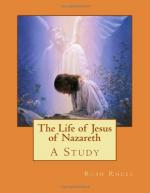191. Whatever the conclusion concerning the date of the last supper, and consequently of the crucifixion, the last meal of Jesus with his disciples was for that little company the equivalent of the Passover supper. Luke states that the desire of Jesus had looked specially to eating this feast with his disciples (xxii. 15). The reason must be found in his certainty of the very near end, and in his wish to make the meal a preparation for the bitter experiences which were overhanging him and them.
192. It is customary to connect as occasion and consequence the dispute concerning precedence which Luke reports (xxii. 24-30), and the rebuke which Jesus administered by washing the disciples’ feet (John xiii. 1-20). The jealousies of the disciples may have arisen over the allotment of seats at the table, as Dr. Edersheim has most fully shown (LJM ii. 492-503); such a controversy would be the natural sequel of earlier disputes concerning greatness, and particularly of the request of James and John for the best places in the coming kingdom (Mark x. 35-45), and would lead as naturally to the distress of heart with which Jesus declared that one of the disciples should betray him, and that another of them should deny him. The narrative in Mark favors the withdrawal of Judas before the new rite was appointed. This must seem to be the probability in the case, for the presence of Judas would be most incongruous at such a memorial service. John’s mention of his departure before the announcement of Peter’s approaching fall confirms this interpretation of Mark (Mark xiv. 18-21; John xiii. 21-30).
193. The paschal memories furnished to Jesus an opportunity to establish for his disciples an institution which should symbolize the new covenant which he was soon to seal with his blood. Jesus regarded this new covenant as that which was promised by the prophets, especially Jeremiah (xxxi. 31-34), and his thought, like that of the prophets, goes back to the story of the covenant established at Sinai (Ex. xxiv. 1-11). In this way he gave to his disciples a conception of his death, which later, if not immediately, would help them to regard it as a necessary part of his work as Messiah. They were now oppressed by the evident certainty that the near future would bring their Master to death; he accordingly gave them a sacred reminder of himself and of his death as an essential part of his self-giving “for them;” for whatever the conclusion concerning the disputed text of Luke (xxii. 19), the institutional character of the act and words of Jesus is clear. As Holtzmann remarks (NtTh i. 304): “The words ‘this do in remembrance of me’ were perhaps not spoken; all the more certainly do they of themselves express what lay in the situation and made itself felt with incontestable conclusiveness.”




